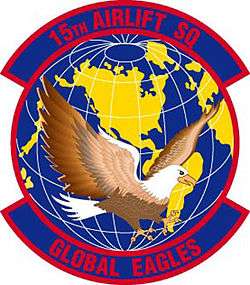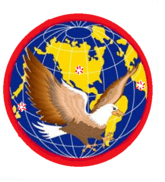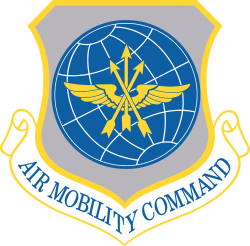15th Airlift Squadron
| 15th Airlift Squadron | |
|---|---|
 A 437th Airlift Wing C-17A Globemaster III deployed to Kandahar Airfield, Afghanistan | |
| Active | 1940–1945; 1946–1993; 1993–present |
| Country |
|
| Branch |
|
| Role | Airlift |
| Part of | Air Mobility Command |
| Garrison/HQ | Charleston Air Force Base |
| Nickname(s) | Global Eagles |
| Engagements |
Mediterranean Theater of Operations European Theater of Operations Korean War[1] |
| Decorations |
Distinguished Unit Citation Air Force Outstanding Unit Award Republic of Korea Presidential Unit Citation Republic of Vietnam Gallantry Cross with Palm[1] |
| Insignia | |
| 15th Airlift Squadron emblem (approved 14 June 1977)[1] |
 |
| 15th Troop Carrier Squadron emblem (approved 16 July 1952)[2] |
 |
The 15th Airlift Squadron is part of the 437th Airlift Wing at Charleston Air Force Base, South Carolina. It operates Boeing C-17 Globemaster III aircraft supporting the United States Air Force global reach mission worldwide.
History
World War II
Activated in December 1940 flying converted Douglas DC-2 transport aircraft as a GHQ Air Force transport squadron. Converted to Douglas C-47 Skytrains in early 1942, trained under I Troop Carrier Command for combat operations. Assigned to Twelfth Air Force and deployed North Africa during May 1943. The squadron's aircraft flew supplies to front-line units in Algeria and Tunisia during the North African Campaign as soon as suitable landing strips were available and evacuated casualties back to rear area field hospitals.
Squadron engaged in combat operations, dropping airborne units into Sicily during the Operation Husky invasion and later into areas around Anzio, Italy as part of Operation Shingle, the invasion of mainland Italy and the initiation of the Italian Campaign, January 1944. Moved north though Italy, in 1943 in support of Allied ground forces, evacuated wounded personnel and flew missions behind enemy lines in Italy and the Balkans to haul guns, ammunition, food, clothing, medical supplies, and other materials to the partisans and to drop propaganda leaflets.
Moved to England in February 1944, assigned to IX Troop Carrier Command. Prepared for the invasion of Nazi-occupied Europe. In June 1944, subordinate units dropped paratroops in Normandy, subsequently flying numerous missions to bring in reinforcements and needed supplies. During the airborne attack on the Netherlands (Operation Market Garden, September 1944), the squadron dropped paratroops, towed gliders, and flew resupply missions. Several of its subordinate units also participated in the invasion of southern France in August 1944. The 50th supported the 101st Airborne Division in the Battle of the Bulge by towing gliders full of supplies near Bastogne on 27 December 1944.
When the Allies made the air assault across the Rhine River in March 1945, each aircraft towed two gliders with troops of the 17th Airborne Division and released them near Wesel. The squadron also hauled food, clothing, medicine, gasoline, ordnance equipment, and other supplies to the front lines and evacuated patients to rear zone hospitals.
In late May 1945, after V-E Day, the squadron moved to Waller Field, Trinidad and attached to Air Transport Command. From Trinidad, the squadron ferried returning military personnel to Morrison Field, Florida, where they were sent on to other bases or prepared for separation after the war.
Global airlift
During the Cold War the 15th was involved in the Berlin Airlift from 1948 to 1949; aerial transport from the U.S. to Japan, August–December 1950; and between Japan and Korea, 13 December 1950 – November 1952. It has carried out worldwide airlift since 1953, including to Southeast Asia from 1966 to 1973 and supporting military operations in Grenada, October–November 1983; Panama, 18 December 1989 – 8 January 1990 and to Southwest Asia, August 1990 – January 1991.
Lineage
- Constituted as the 15th Transport Squadron on 20 November 1940
- Activated on 4 December 1940
- Redesignated 15th Troop Carrier Squadron on 4 July 1942
- Inactivated on 31 July 1945
- Activated on 30 September 1946
- Redesignated 15th Troop Carrier Squadron, Medium on 1 July 1948
- Redesignated 15th Troop Carrier Squadron, Heavy on 15 August 1948
- Redesignated 15th Military Airlift Squadron on 8 January 1966
- Redesignated 15th Airlift Squadron on 1 January 1992
- Inactivated on 26 July 1993
- Activated on 1 October 1993[1]
Assignments
- 61st Transport Group (later 61st Troop Carrier Group), 4 December 1940 – 31 July 1945
- 61st Troop Carrier Group, 30 September 1946
- 63d Troop Carrier Group, 8 October 1959
- 63d Troop Carrier Wing (later 63d Military Airlift Wing), 18 January 1963
- 63d Military Airlift Group, 1 October 1978
- 63d Military Airlift Wing, 1 July 1980
- 63d Operations Group, 1 January 1992 – 26 July 1993
- 437th Operations Group, 1 October 1993 – present[1]
Stations
|
|
Aircraft
|
|
Awards and campaigns
- Campaigns. World War II: Sicily; Naples-Foggia; Normandy; Northern France; Rhineland; Central Europe. Korea: CCF Intervention; First UN Counteroffensive; CCF Spring Offensive; UN Summer-Fall Offensive; Second Korean Winter; Korean Summer-Fall, 1952.
- Decorations. Distinguished Unit Citations: Sicily, 11 July 1943; France, [6–7] Jun 1944; Korea, 13 Dec 1950 – 21 Apr 1951. Air Force Outstanding Unit Awards: 1 Jul 1957 – 10 Dec 1962; 1 Jul 1968 – 30 Jun 1969; 1 Jul 1970 – 30 Jun 1971; 1 Jun 1978 – 31 May 1980; 1 Jan-31 Dec 1983; 1 Jan-31 Dec 1987; 1 Jan 1990 – 30 Apr 1991. Republic of Korea Presidential Unit Citation: 1 Jul 1951–[18 Nov 1952]. Republic of Vietnam Gallantry Cross with Palm: 1 Apr 1966 – 8 Jan 1973.
References
Notes
Bibliography
![]()
- Anderson, Capt. Barry (1985). Army Air Forces Stations: A Guide to the Stations Where U.S. Army Air Forces Personnel Served in the United Kingdom During World War II (PDF). Maxwell AFB, AL yes: Research Division, USAF Historical Research Center. Archived from the original (PDF) on January 23, 2016. Retrieved June 28, 2017.
- Johnson, 1st Lt. David C. (1988). U.S. Army Air Forces Continental Airfields (ETO) D-Day to V-E Day (PDF). Maxwell AFB, AL: Research Division, USAF Historical Research Center. Archived from the original (PDF) on September 29, 2015. Retrieved June 26, 2017.
- Maurer, Maurer, ed. (1983) [1961]. Air Force Combat Units of World War II (PDF) (reprint ed.). Washington, DC: Office of Air Force History. ISBN 0-912799-02-1. LCCN 61060979. Retrieved December 17, 2016.
- Maurer, Maurer, ed. (1982) [1969]. Combat Squadrons of the Air Force, World War II (PDF) (reprint ed.). Washington, DC: Office of Air Force History. ISBN 0-405-12194-6. LCCN 70605402. OCLC 72556. Retrieved December 17, 2016.
- Ravenstein, Charles A. (1984). Air Force Combat Wings, Lineage & Honors Histories 1947-1977 (PDF). Washington, DC: Office of Air Force History. ISBN 0-912799-12-9. Retrieved December 17, 2016.


.svg.png)